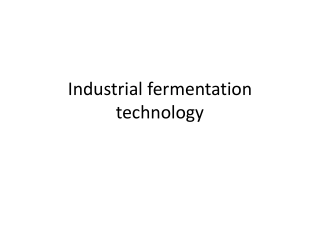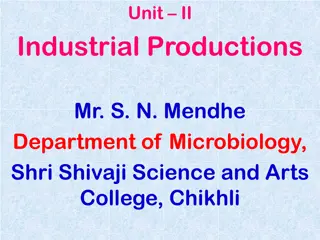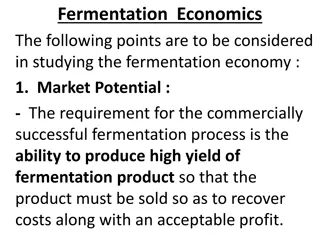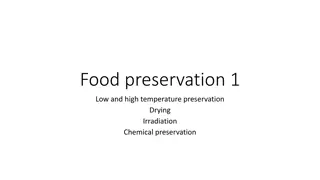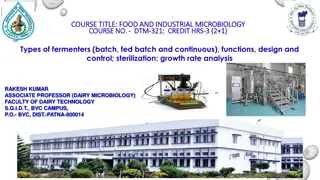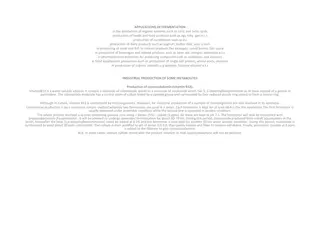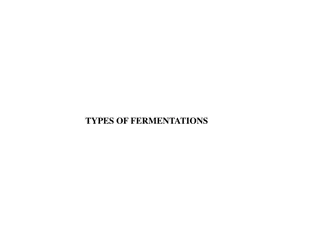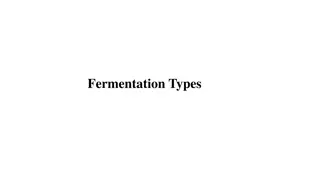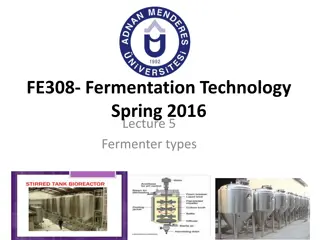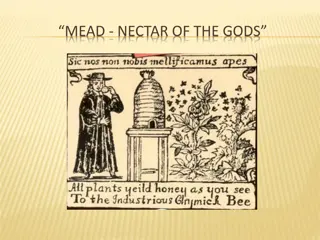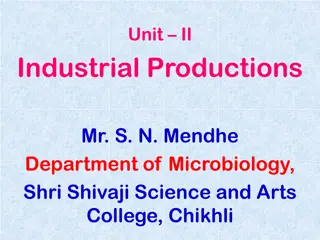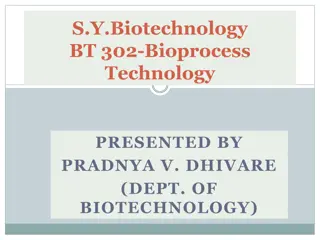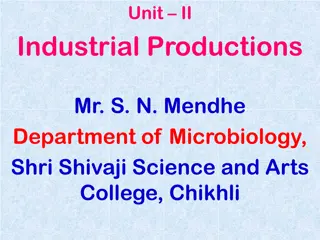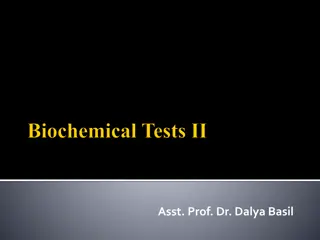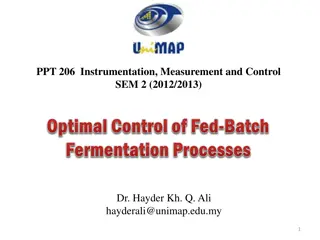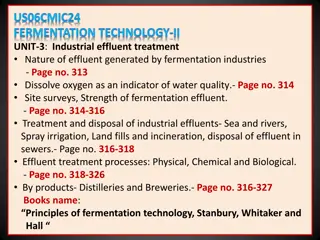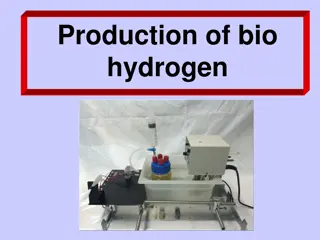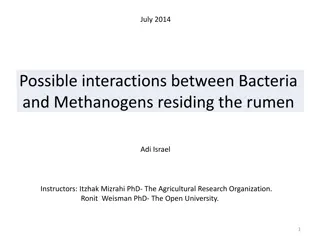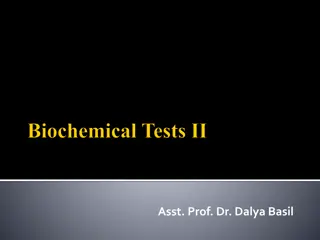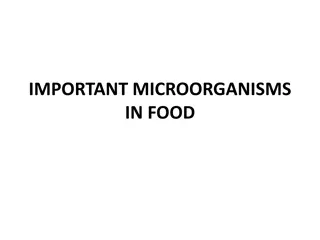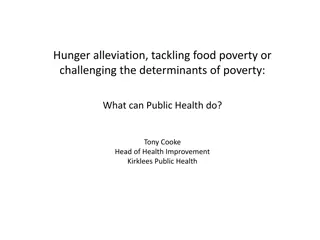The Fascinating World of Food Fermentation
Explore the rich history and benefits of fermentation, from the early nomads' discovery of cheese and yogurt to Louis Pasteur's groundbreaking work. Learn about the different types of respiration, microbial fermentation in food production, and the energy-releasing process of cell respiration. Discover how fermentation extends food storage, enhances taste, and creates versatile products like chocolate and coffee.
Download Presentation

Please find below an Image/Link to download the presentation.
The content on the website is provided AS IS for your information and personal use only. It may not be sold, licensed, or shared on other websites without obtaining consent from the author. Download presentation by click this link. If you encounter any issues during the download, it is possible that the publisher has removed the file from their server.
E N D
Presentation Transcript
https://encrypted-tbn0.gstatic.com/images?q=tbn:ANd9GcSfUr7Jx8NTHoa3P8wVk9AhowRGNpEjUlTALvUA94CLaQFygaK7https://encrypted-tbn0.gstatic.com/images?q=tbn:ANd9GcSfUr7Jx8NTHoa3P8wVk9AhowRGNpEjUlTALvUA94CLaQFygaK7 THE FERMENTATION OF FOOD THE FERMENTATION OF FOOD http://selfhealgo.com/wp-content/uploads/2012/05/pickled-vegetables.jpg Chapter 22
Objectives Objectives Terms Terms Aerobic Anaerobic Anaerobic Respiration Brine Brine Pickling Cell Respiration Fresh-pack Pickling Indigenous Microbes Microorganisms Pasteurization Describe the history of fermentation Explain why food is fermented Compare respiration in human metabolism to anaerobic respiration in food science Explain what causes fermentation Summarize information on bacterial fermentation works in bread making Explain the value of molds and enzymes in food production Describe how various fermented beverages are made
Fermentation in History Fermentation started taking place before recorded history Nomads noticed that milk would change to solid cheese or semisolid yogurt under certain conditions For centuries people have made alcoholic beverages by using yeast to ferment fruit juices In the 1850 s wine was spoiling so Louis Pasteur realized that certain bacteria in the wine were also fermenting and spoiling the wine. Pasteur suggested heat treating the wine to kill bacteria, the process of pasteurization is still used today, most commonly for milk
Benefits of Fermentation Extends the time food can be stored without spoiling Some foods are more enjoyable to eat when fermented Example easier to chew Makes some foods more usable Examples chocolate or coffee
Human respiration vs. Anaerobic Respiration - In human respiration uses oxygen, but in anaerobic respiration uses electron acceptors instead of oxygen. - Primary goals are the same.
The Fermentation Process Cell Respiration- process releases energy from glucose when the glucose molecules in the cell is broken down Aerobic- reaction taken place in the presence of air or oxygen Anaerobic- reaction occurring in the absence of oxygen Anaerobic Respiration- respiration that occurs without oxygen Microorganisms or Microbes are single cells of microscopic sizes that cannot be seen by the human eye
Bacterial Fermentation Lactic acid bacteria Used to produce pickles and sauerkraut Acetic acid bacteria use fermentation in the vinegar making process Carbon dioxide bacteria used to make Swiss cheeses Proteolytic bacteria break down protein in cocoa and chocolate for candy and beverages
Sources of Bacteria Indigenous- found naturally in a particular environment such as cabbage and cucumbers Lactic-Acid- used in yogurt, sour cream, cottage cheese, cheddar cheese, dill pickles, olives, sauerkraut and vanilla
Pickles Brine- a water-and-salt mixture that contains large amounts of salt Brine Pickling- the vegetable remains in the brine for several weeks until a low pH is reached Fresh-pack Pickling- the vegetable is in the brine overnight
Sauerkraut Bacteria growth promoted soil-borne, lactic-acid on the surface of cabbage Washing before shredding helps the bacteria grow Salt helps produce lactic acid pH lowers during fermentation How to make sauerkraut the easy way!(4:09) http://www.youtube.com/watch?v=lpkQbhq4bYQ
Yeast Fermentation Fermentation (5:38) http://www.youtube.com/watch?v=4SosPuWAg7g
Enzymes and Molds Enzymes are protein molecules that are the catalysts to all chemical reactions. Enzymes are important because they help break down foods and absorb nutrients we need. Some molds are safe to eat and some are not. Good molds are used in cheeses and in yogurt and are safe to be manufactured and eaten. How to Make Greek Yogurt at Home (9:39) http://www.youtube.com/watch?v=5ZZAUqFqAnY
Fermentation of Beverages Fermented Lemonade (6:16) http://www.youtube.com/watch?v=46nKpErTgZ8 Hot Cocoa (5:41) http://www.youtube.com/watch?v=GXI5hd6pKds


